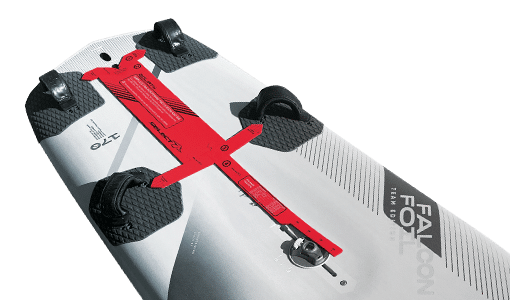Tips and Tricks
The correct operation of a foil is complex; many parameters come into play: the rider’s size and sailing style, the equipment used (type of board and rig), sailing conditions, etc… Each of these parameters generates variable forces.
The combination of all these forces is likely to upset the stability of the foil’s balance.
Also, in some cases and in certain configurations, an adjustment is necessary to re-establish balance and fine-tune the stability of your flight.
Here are a few tips and basic principles that will help you personalize your settings to take full advantage of all the Goliath’s qualities and further enhance your performance.
Goliath Template
POSITIONING THE FOOTSTRAPS AND THE RIG
To help you position your footstraps and your rig depending the on sail area, SELECT propose a template to get the best performances with a good balance using fuselages VECTOR 1100 and 970 of the Goliath foil


1 / Place the part #1 on the front screw of the borad tuttle box. This will give you the median position of the rear footstraps
2 / Set part #2 in part #1. Part #2 defines the distance between the rear footstraps and the front footstraps
3 / Set part #3 in part #2 and find the median position of the front footstraps
4 / Set part #4 in part #3: Follow the instructions regarding your sail size in the table RIG BASE POSITION and find the correct rig position
Base Settings
STABILIZER ADJUSTMENT
The stabilizer is always a «spoiler».
It pushes in the rear of the foil on take-off, and it is simply the placement of the rider’s center of gravity and the sail’s center of thrust that will more or less reduce the offset effect.
As soon as the rider’s center of gravity and sail thrust exceed the center of thrust of the foil’s front wing, the rider has the option of constraining the stabilizer offset to fly balanced and stabilized.
Without a stabilizer, we would never have the sensation of having to push on the front leg
THE FEEL ON THE FRONT LEG DEPENDS ON THE CHOICE OF THE STABILIZER
For a good stabilizer setting, the feeling on the front leg will always be the reference point :
– When flight is balanced and stable: pressure on the front leg is light and comfortable.
– If the pressure on the front leg is too low : Taking off and maintaining flight are complicated, as the foil create a nose down moment
> Solutions : all the possibilities are listed below (but they do not necessarily add up)
1 – Move your foot straps back.
2 – Move the rig back to shift the center of gravity aft.
3 – Tilt the stabilizer with a positive shim. (Caution: while the positive incidence of the horizontal stabilizer increases its lift power, it also generates more drag, to the detriment of speed).
4 – Fit a larger stabilizer (i.e., one with more lift) to generate the right balance (this option keeps the basic incidence of the stabilizer/+0.5°… the ideal setting for not altering speed potential).
5 – Fit a larger front wing.
– If the pressure on the front leg is too high : Take-off and sustained flight are uncontrollable, as the foil is too «buoyant».
> Solutions:
1 – Move your foot straps forward.
2 – Move the rig forward to shift the center of gravity forward.
3 – Fit a smaller stabilizer (less weight-bearing).
4 – Fit a smaller front wing.
Please note : stabilizer sizes also depend on the power of the front wing. You will need more or less power depending on your size, and on conditions and sail area.
NEW-GENERATION FOILS
